The Bible’s Big Story – a Pictorial Timeline of the Scriptures
The sequence of picture frames below shows the historical progression of time through the major sections of the Bible, helping students understand the overarching story of Scripture, from beginning to end. — © Harry N. Wendt 2005

FRAME 1: In the Beginning
The biblical narrative begins in detail when God calls the patriarchs, Genesis 12: 1–3. Genesis 1–11 explains why God called them. This section of the Bible is referred to as “prehistory” — exact period of time from creation to Abraham is unknown. Frame 1 contains five parts:
1) Genesis 1:1–2:4a: In its teaching graphics, this timeline uses a circle with four protruding arrows as the symbol for God. (Circle: God is one, without beginning or end. Protruding arrows: God acts in love, which always goes out from God.) Beneath it are reminders that God created the universe; the sun, moon and stars; trees, birds, animals, streams, fish; people, who were to know and praise God. Four major narratives follow.
2) Humanity’s sin fragments the relationship between God and humanity, and between male and female, Genesis 2 and 3.
3) Cain’s sacrifice is rejected by God, Abel’s is accepted. Cain kills Abel, and family relationships are fragmented, Genesis 4 and 5.
4) Genesis 6:1–4, a difficult passage, describes divine beings being sexually intimate with earthly women. Cosmic chaos results. God puts an end to Creation One through a flood, commands Noah to build a large ark to preserve human and animal life, and makes a new beginning to creation and history through Noah and his family, Genesis 6:5–9:29.
5) People begin to build a tower to reach heaven, to make a name for themselves and to avoid being scattered. When God halts the project by confusing their languages (mouth) humanity is fragmented and scattered, Genesis 11:1–9.
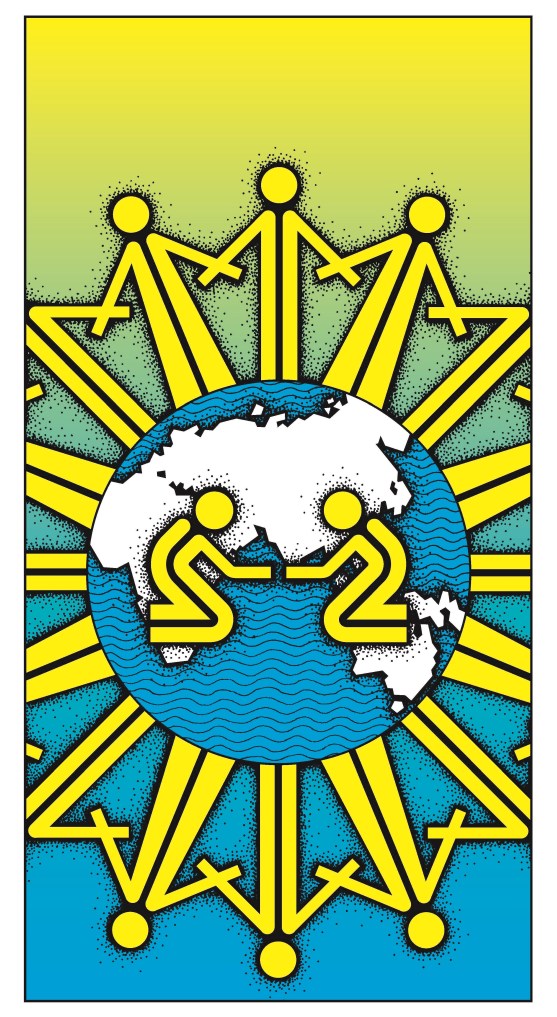
FRAME 2: God’s Plan for Creation
The first section of frame 1 shows two people with hands raised praising God for divine goodness, creation and life.
When God gave humanity “dominion over” the created order, that did not imply ownership of creation, but the responsible use of creation for God, Genesis 1:26–28. God has not given, but entrusted, creation to humanity — to manage it to God’s glory and for the benefit of all. People are not to do as they please, but are to do what pleases God and benefits others. Praise is to demonstrate itself in obedience; people are to live to serve God and each other, in community.
Frame 2 shows God’s plan for a creation where all things are good and in order — a plan designed to ensure the well-being of creation and the happiness of humanity. Unity prevails. The human family lives in harmony as a serving community. Things are as God intends them to be.
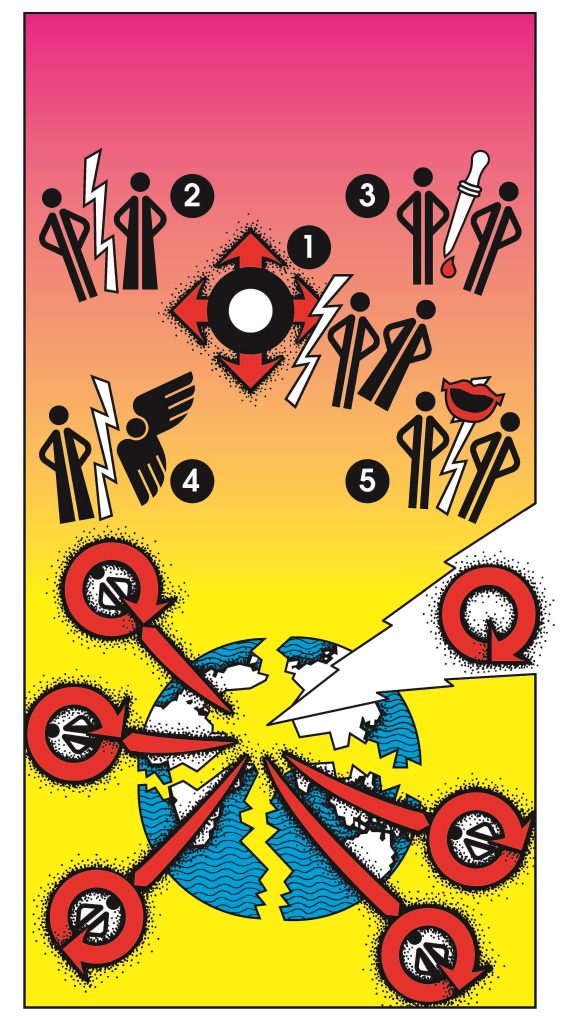
FRAME 3: Consequences of Sin
After sin breaks in, humanity becomes turned in on self; people serve themselves rather than God and others. Genesis 3 describes sin crashing into creation like a thunderbolt. Note the symbol for sin — the arrow turned in on itself. The fragmentation that takes place when sin breaks into God’s good creation is depicted in the upper section of frame 3. There is fragmentation between:
1) God and humanity, Genesis 3.
2) Male and female, Genesis 3.
3) Brother and brother — like parents, like offspring, Genesis 4.
4) Heavenly and earthly realms, Genesis 6:1–4.
5) Nation and nation, brought about by the pride which caused the confusion of languages, Genesis 11:1–9.
In the lower section of Frame 3, servanthood in community is replaced by the curse and captivity of individualism. Those who wish to be free from God are enslaved by self.

FRAME 4: God’s Covenant with Abraham
(c. 2000 – 1800 B.C.)
Back in Frame 1, as the generations (between lines) broaden out to the end of the frame, we see the people are in the posture of indifference to, and rebellion against, God. Another two lines converge on the three persons at the beginning of the central line; the three persons are Abraham, Sarah and Isaac.
Frame 4: In Genesis 12:1–3, God commands Abraham to go to the land of Canaan, promises that a large nation will develop from him (five people), and blessings will flow to the nations through his descendants (cup of blessing from Canaan flows over the world). Later verses state that God entrusted the land to Abraham and his descendants, Genesis 12:7, 13:15.
Genesis 15:7–21 describes God making a Covenant of Divine Commitment concerning the land, in the course of which God (symbolized by a fire-pot and torch) passes between animals cut in half.

FRAME 5: Journey of the Ancestors
(c. 1800 – 1500 B.C.)
Genesis 11:27–32 says the patriarchs traveled from Ur of the Chaldees to Haran in Syria. The patriarchs practiced idolatry prior to Abraham’s call, Josh.24:2, 14,15; note the idols near the ziggurat at Ur.
Genesis 12–25 contains numerous “cliff-hangers”: Will Abraham be able to keep his wife? Will they ever have children? Who will inherit the promise, Ishmael or Isaac? Will the patriarchs inherit the land? When? At the end of his life, Abraham owns only a small field and a burial cave in Canaan (depicted), Genesis 23. Later, Jacob, not Esau, inherits the birthright, Genesis 25:19–34. Genesis chapters 46–50 describe Jacob and his clan as happily settled in Egypt (pyramid).
Genesis also describes the origins of Israel’s neighbors: Canaanites (9:20–27), Ishmaelites (ch. 16), Moabites and Ammonites (19:30–38), Midianites (25:2) and Amalekites (36:12).

FRAME 6: Moses and the Exodus
(c. 1500-1400 B.C. or 1300-1200 B.C.)
Eventually Abraham’s descendants find themselves in bondage because of a pharaoh who forgot Joseph, Exodus 1:8. But God uses Moses to break their chains and bonds, and rescue them from the pharaoh through a series of devastating plagues, a “holy war” God wins.
God then opens up the waters to lead the people out of Egypt to Mt. Sinai, where God makes a Covenant of Human Obligation with them — spelling out what God has done for them and how they are to respond in gratitude, by practicing servanthood in community, Exodus 20:1–17.
God takes up residence among the Israelites above the Ark of the Covenant in the Tabernacle and leads them through the wilderness into the Promised Land. The Israelites disobey and murmur repeatedly during the wilderness period; note Ezekiel 20. They eventually receive the land because of grace not merit.
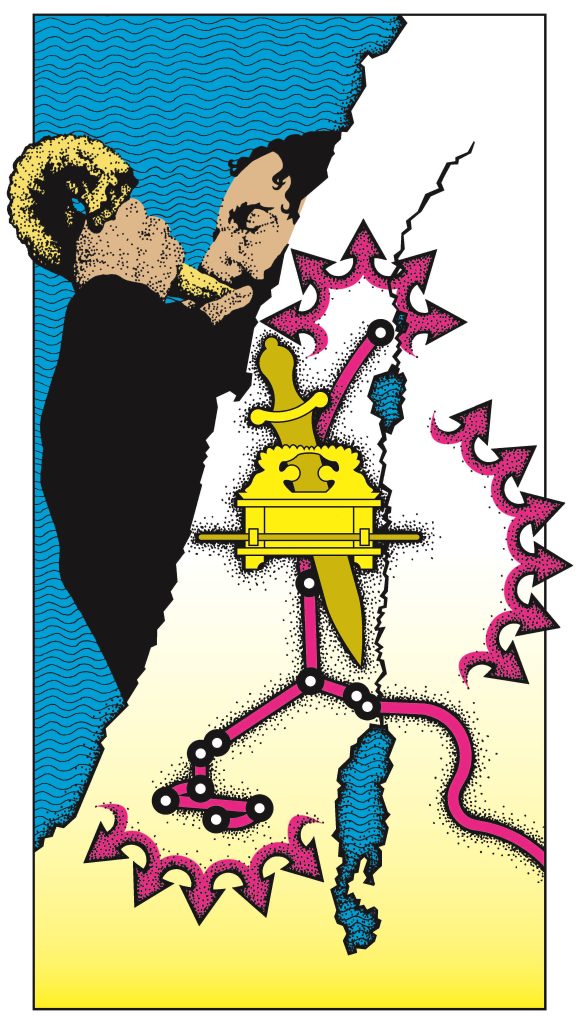
FRAME 7: Joshua and the Conquest
(c. 1200 – 1100 B.C.)
Joshua describes events associated with the conquest: preparations, chapters 1–5; the conquest by a united Israel, chapters 6–12; the division of the land, chapters 13–21; covenant ceremonies at Shechem, 8:30–35, ch. 24; Joshua’s farewell speech, ch. 23, and death, 24:29,30.Throughout, God is “commander-in-chief.” Joshua, God’s general, leads a united Israel. The conquest is swift and complete.
When the people trust God, and let God devise the strategy and lead them into battle, they overcome the Canaanites. When they devise their own strategies, they lose. After the people enter the land, the manna stops, Joshua 5:10–12; they hope it will fall again when the Messiah comes, John 6; see 2 Baruch 29:8.
God continues to own the land. If the people persist in disobedience, God will throw them out of it, Leviticus 26; Deuteronomy 28:15–68.
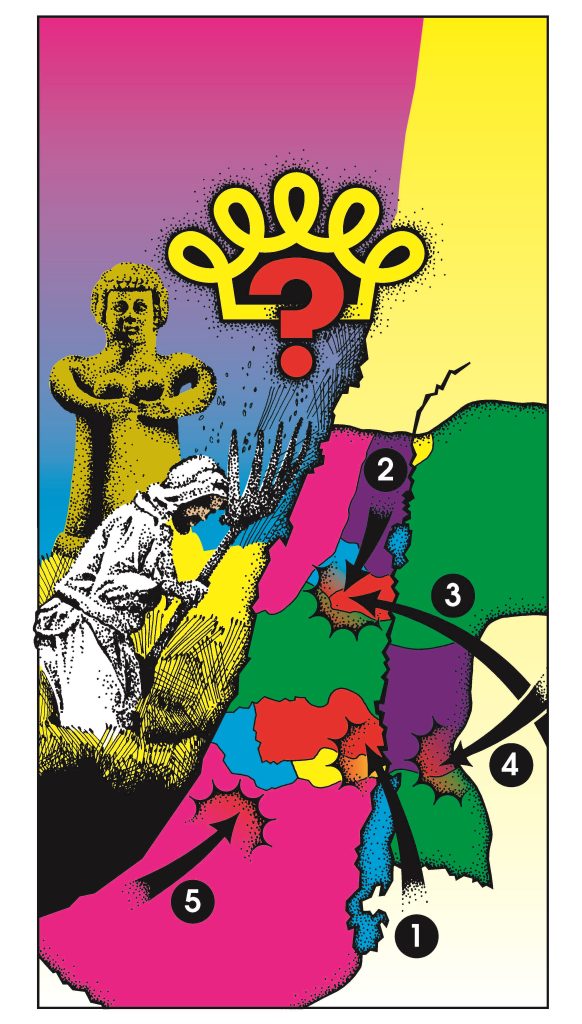
FRAME: 8: The Time of the Judges
(c. 1100 – 1000 B.C.)
Judges chapters 1–3 seem to contain another version of the conquest in which each tribe strives individually to capture the territory allotted to it; note also Joshua 24:29,30 and Judges 2:6–10.
Because the Israelites do not eliminate the Canaanites, they marry Canaanite women and worship Canaanite fertility gods. God in turn permits Israel’s neighbors to attack them (chapters 3–16), among whom were: Moabites, Canaanites, Midianites, Ammonites, and Philistines
God raises up tribal chieftains called Judges to deliver His people. Israel now faces three serious problems: (1) national fragmentation, (2) dynastic uncertainty, (3) religious polytheism. Judges 17 and 18 describe the origins of a shrine at Dan. Judges, chapters 19–21 describe the Benjaminites getting wives from Jabesh-gilead.

FRAME 9: The United Monarchy
(c. 1000 – 900 B.C.)
Eventually Israel faces leadership and succession problems (1 Samuel 2:12–18, 23–25; 8:1–3) and Saul is chosen as ruler (1 Samuel 8–11). Some narratives refer to him as king (sometimes good, sometimes bad), others as prince or leader (always good). Saul’s reign is viewed negatively. He interfered in priestly duties (1 Samuel 13), and spared one of Israel’s enemies in a holy war (1 Samuel 15).
David’s reign is praised, 1 Samuel 16–1 Kings 2:9. Though his personal life leaves much to be desired, he gives the nation: (1) unity, 2 Samuel 1–5; (2) an empire (depicted above), 2 Samuel chapters 8,10; (3) Jerusalem, 2 Samuel 5:6–10; (4) a royal sanctuary in Jerusalem, 2 Samuel 6; (5) a dynasty, 2 Samuel 7:1–17.
The statement that David was a man “after God’s own heart” (1 Samuel 13:14) means that David worshipped one God in Jerusalem (see 1 Kings 3:3. 9:1–9; 11:4–8).

FRAME 10a: Solomon’s Temple
(c. 970 – 960 B.C.)
In the top left section of frame 9 are four crowns and a question mark—details that point to the bloody struggle among David’s sons for the throne prior to and after David’s death, 2 Samuel 13:1–1 Kings 2:46. Solomon emerges the victor and organizes his realm into a military state, 1 Kings 4:7,19,26–28.
The narrative that praises Solomon for seeking wisdom and not the death of his enemies (1 Kings 3:10–14) ignores the fact that Solomon has previously killed his brother Adonijah, his cousin Joab, Shimei (who opposed his father, 2 Samuel 16:5–14, 19:16–23), and exiled a priest, 1 Kings 2:10–46.
Much of the narrative describing Solomon’s reign (1 Kings 2:10–11:43) focuses on Solomon’s building program, especially the Temple (top) —but also an administrative complex, a palace and fortresses (echoed in the prophetic vision in Ezekiel 43:6–12).
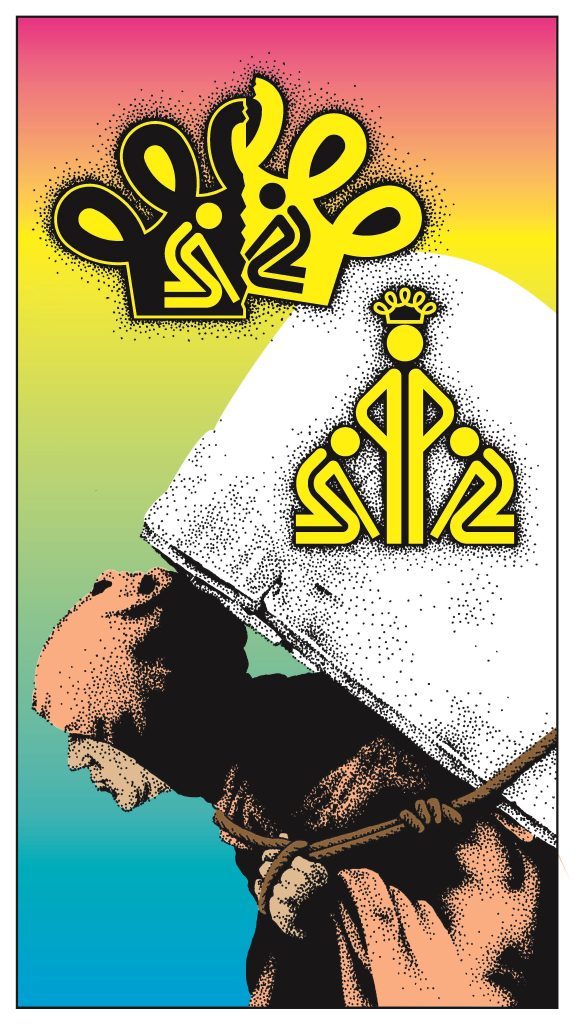
FRAME 10b: Division of the Kingdom
(922 – 722 B.C.)
Solomon accomplishes much, but he does so by enslaving his own people (1 Kings 4:6, 5:13, 9:1, 12:1–15) (burden). What’s more, Solomon has many wives and concubines, and involves himself in their idolatrous worship (1 Kings 11:1–9). Because he organized the realm to serve him, rather than himself to serve the realm (center right), upon his death the nation splits (top) into the southern kingdom of Judah and the northern kingdom of Israel.
At this point, the northern kingdom establishes its own line of kings — the first of whom establishes shrines at Bethel and Dan. 1 and 2 Kings despise all northern kings for not worshipping in Jerusalem. The shrine at Bethel eventually became the royal chapel of the Northern Kingdom, Amos 7:10–13.The polytheistic practices Solomon introduced into the nation remained in place until Josiah’s reform in 621 BC (2 Kings chapters 22-23).
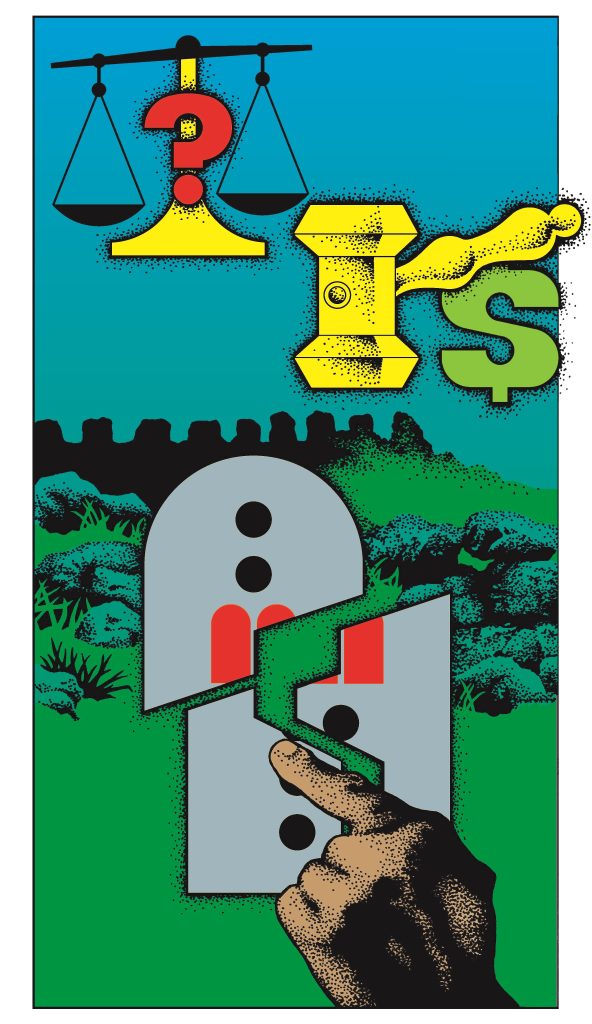
FRAME 11a: Warning of Judgment
(c. 900 – 600 B.C.)
The history of the united and divided kingdoms (1 and 2 Kings) was completed during the Babylonian exile, 2 Kings 25:27–30. In seeking to avoid a repetition of the disaster, it set out to determine why the nation collapsed. The narrative insists that the nation must do away with the worship of other gods, and, like David, worship the only true God in one place, Jerusalem (2 Kings 22:1 – 23:25).
While the kings do their things, the prophets proclaim their message with fire in the eye and wind in the hair and beard. Israel has ignored and broken the Sinai covenant (lower). The prophets insist that the people must take the covenant deadly seriously; even the kings must live under it and rule according to its stipulations. If they do not, the covenant curses will come into effect and the nation will go into exile.

FRAME 11b: The Prophetic Message
(c. 900 – 500 B.C.)
Among other things, the prophetic attacks declare: business practices are corrupt, and people are greedy for money (Micah 6:10–12, 3:9–11); justice and bribery go hand in hand, Amos 5:10,11. The message religious leaders deliver is influenced by what they are paid (Micah 3:5) (mouth and dollar sign). God will soon use Israel’s neighbors like a leopard (top right) to maul a forgetful people (Hosea 13:6–8), and reduce their fortresses and buildings to rubble ( Amos 5:11,12).
At the same time, some of the prophets hope that the day will come when God’s mercy will prevail over a nation that does not know God, and God will finally get God’s grace, truth and will into their hearts, Jeremiah 31:31–34 (lower right). When destruction finally overtakes them, the prophets then begin to offer words of consolation and hope (Ezekiel 34,36,37; Isaiah 40-55).
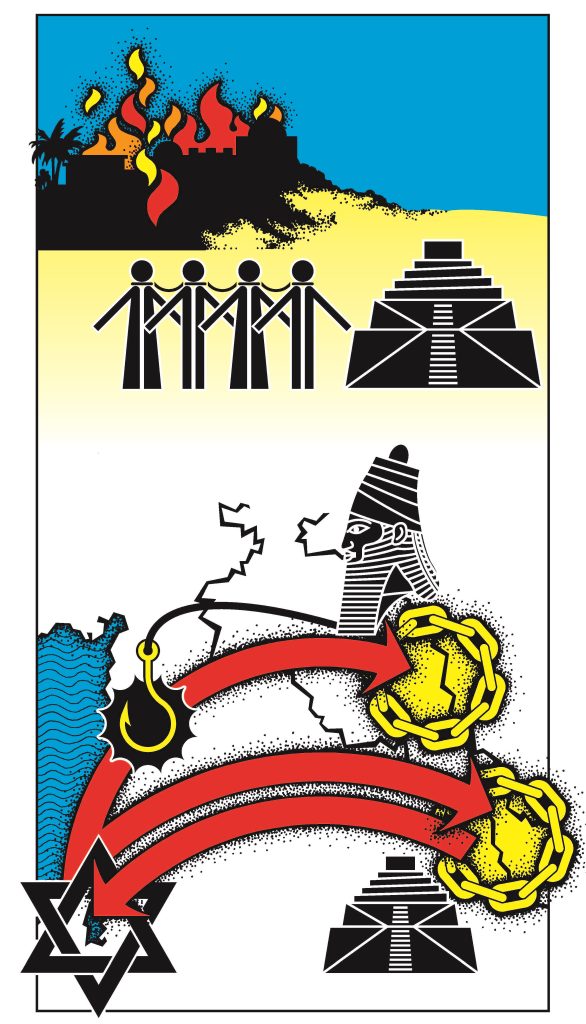
FRAME 12: Conquered and Exiled
(722 – 539 B.C.)
In 721 B.C. the Assyrians, under Sargon II, overrun the Northern Kingdom of Israel, lead its people into exile, and make Judah a vassal nation; note Amos’ comments about fish hooks, 4:2.
In 612 B.C., the Babylonians finally overthrow Assyria and gain control of Judah. In 601 B.C., Jehoiakim of Judah revolts against Babylon, but the revolt is crushed in 597 B.C., and Jehoiakim’s son, Jehoiachin, is taken into exile in Babylon—together with thousands of others.
Some years later, Jehoiachin’s uncle and successor, Zedekiah, revolts—with the result that in 587 B.C., Nebuchadnezzar devastates Judah and flattens Jerusalem and the Temple, kills the king’s sons, and blinds and exiles the king. Both Jehoiachin and Zedekiah die in Babylon. Eventually, in 538 B.C., some of the exiles in Babylon begin to return to Judah. Those who return become known as “Jews” and develop Judaism.
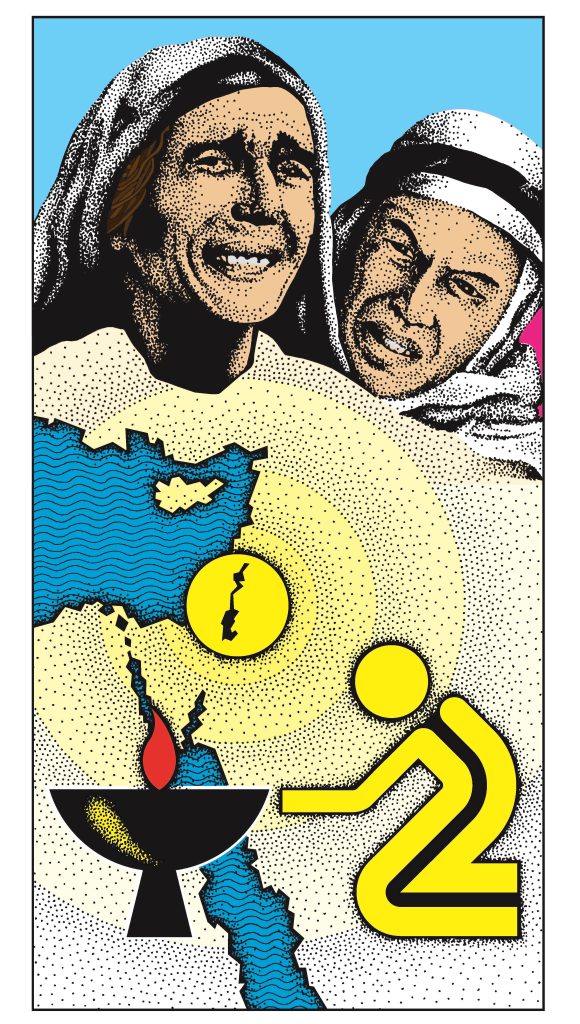
FRAME 13: Life in Exile
(587 – 539 B.C.)
Those taken into exile in Babylon experience agony. How can they worship God in a strange land far removed from Jerusalem, Psalm 137? Does God, can God, live also beyond the borders of Israel, 1 Samuel 26:17–20? Why had God permitted this calamity to overtake the nation?
Even so, a prophet delivers a message of hope and purpose to his people even while they are still in Babylon, Isaiah chapters 40–55. Indeed, the exiles will go back to the land, 40:3–5.True, the people deserved their suffering, but they have now paid double for their sins (Isaiah 40:1,2; see also Jeremiah 16:18). God promises that through them — God’s suffering servant people — divine blessing and healing will flow to the nations, Isaiah 49:1–6 (lower right).
They are, after all, to be a light to the nations, 49:6 (lower left). The prophet describes the “new thing” God is about to do as a new exodus (or rescue) event, Is. 43:14–21.
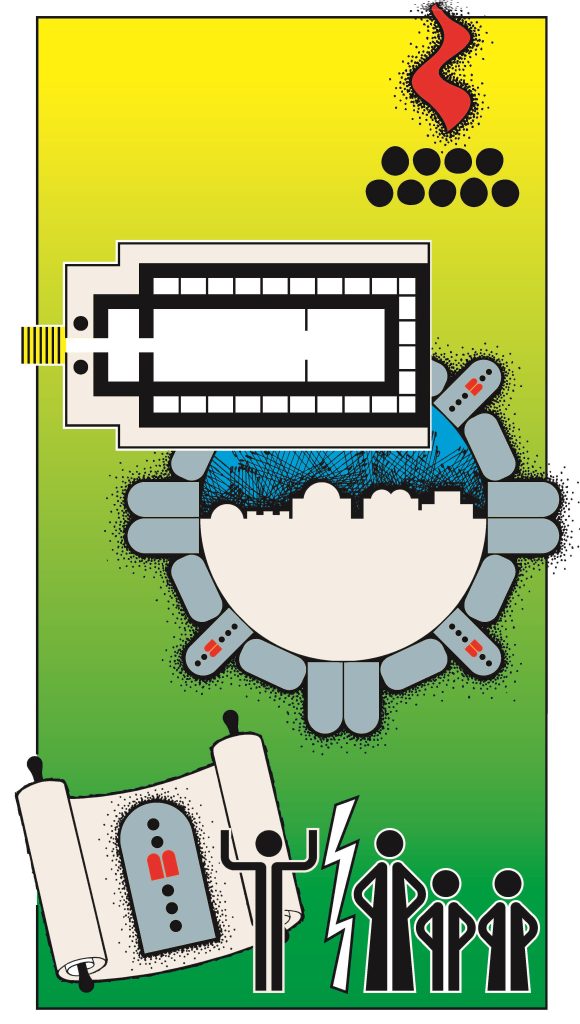
FRAME 14: Returning Home
(539 – c. 400 B.C.)
In 539 B.C. the Persians, under Cyrus, gain control of Babylon. Cyrus permits captive peoples to return to their own lands, and rebuild their temples. Many exiles return to Judah. The first thing they do is to build an altar among Jerusalem’s rubble and offer sacrifice, Ezra 3:1–6 (top right). In 515 B.C., the Second Temple (top center) is dedicated (see Ezra 3:7–4:5 and the Book of Haggai).
Nehemiah supervises the rebuilding of Jerusalem’s walls, Neh. chapters 2–4 (bricks in center circle). Ezra seeks to restore the covenant to a central place, and teaches the people its law-codes, Ezra 8:1–12 (symbols for covenant and law-codes in center circle and at lower left).
Ezra insists that Jewish men who have married Gentile women must rid themselves of those wives and the children of those unions, Ezra 10 (lower right, Jewish male separated from Gentile wife and children). Turning back to God would be hard.
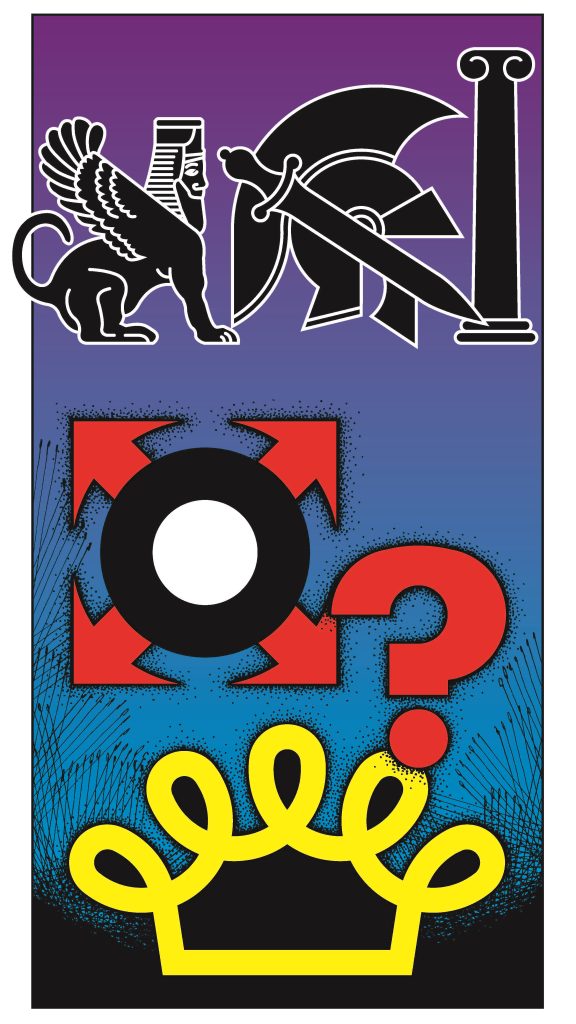
FRAME 15: A Succession of Empires
(c. 500 – 4 B.C.)
The people in Judah continue to live under foreign control. After the Persians (cherub) come the Greeks (Greek helmet and column), and then the Egypt-based Greeks known as Ptolemies, and then the Syria-based Greeks known as Seleucids.
After a period of independence under the Jewish Maccabees and Hasmoneans, Judah comes under Roman control. The people agonize over why God permits them to remain under foreign control, and how long it will be before they are rid of it (symbol for God and question mark). Long gone, many remember the Davidic dynasty was supposed to last forever, 2 Samuel 7:13,16,29.
So the cry goes up: “Will God ever restore the Davidic dynasty and kingdom? Psalm 89 (crown and question mark) Will God ever send a messianic deliverer? Matthew 1:1 answers “Yes!” But God’s Messiah assumed a surprising form.

FRAME 16: A Religion of the Word
(c. 500 – 4 B.C.)
Most likely, Malachi was the last Old Testament prophet. Various suggestions are made as to why the prophets disappear from the scene. Perhaps the people became disillusioned because the hopes to which some of the prophets pointed were not being fulfilled. Perhaps their messages became a little bizarre and they lost credibility; see Zechariah 13:2–6.
Eventually, the written scriptures (Law, Torah) became central and replaced the voice of the living prophet. Scholars pondered their every page, sentence, word and letter — and committed their opinions to writing. They translated them into Greek (the Septuagint).
Jews referred to the Torah as the bread of life, the water of life, and the light of the world (three symbols above scroll). They said that where two or three gathered around the Torah, the Shekinah (presence of God) dwelt among them.
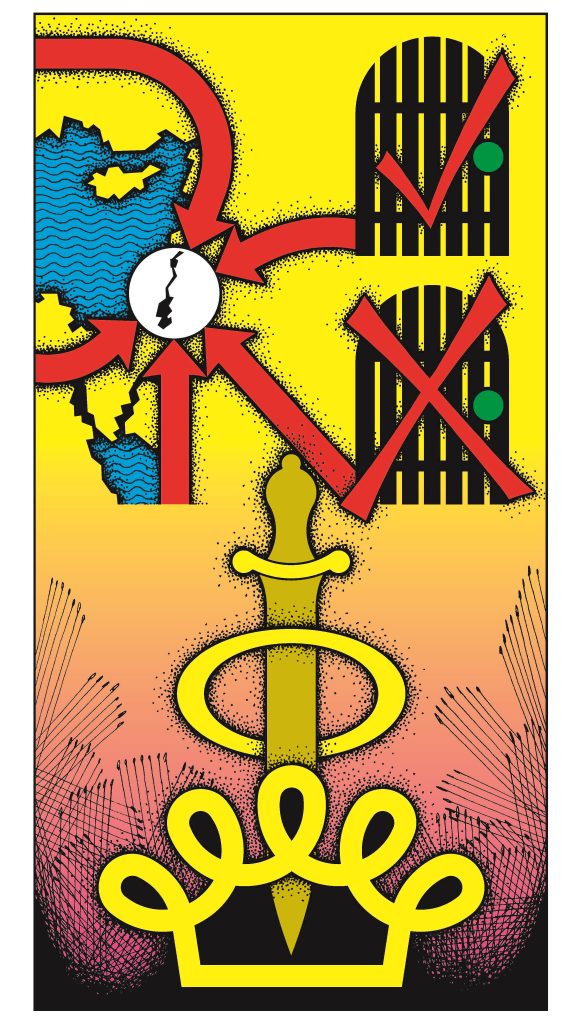
FRAME 17: Longing for a Messiah
(c. 500 – 4 B.C.)
During the centuries preceding the birth of Jesus the Messiah, many hoped that all Jewish exiles scattered around the world would return to Judah—and that even the Gentile nations would come to worship the God of Israel in Jerusalem, Is. 2:2–4 (top left).
Some (for example, the Hasidim, or Pharisees) taught that those Jews who died prior to the coming of the Messianic Age would be raised bodily to partake in it (approval sign on symbol for resurrection—door with slats). Others (the Sadducees) rejected belief in bodily resurrection (symbol for resurrection crossed out).
Many, though not all, looked for the coming of a Messiah or of a Messianic Age. Some looked for the coming of a heavenly king who would destroy the Gentiles (halo, crown, sword), Psalms of Solomon 17 and 18. Some said that the Gentiles would take part in the Messianic Age — but as servants of the Jews (Isaiah 61:5–7).

FRAME 18: The Intertestamental Period
(c. 400 – 4 B.C.)
The time between Old and New Testaments is called the “Intertestmental Period.” The Jerusalem Temple continued to play a key role in Judaism. In 19 B.C., Herod the Great, with Jewish approval, demolished the postexilic Temple and began the building of a grand structure that took 82 years to build. It became the focal point for the Sadducees. The Romans later destroyed it in A.D. 70.
After centuries of sifting through the first five books of the Old Testament, the Pentateuch, the rabbis concluded that they contained 613 laws. They also developed many “oral traditions”(smaller law-codes) around them. These traditions (which they traced back to Sinai and Moses) remained “oral” until they were written down about A.D. 200. The Pharisees focused on the law-codes and oral traditions. Some said that if only all Israel would keep the Law properly for one day, or observe two consecutive Sabbaths correctly, the Messiah would come!
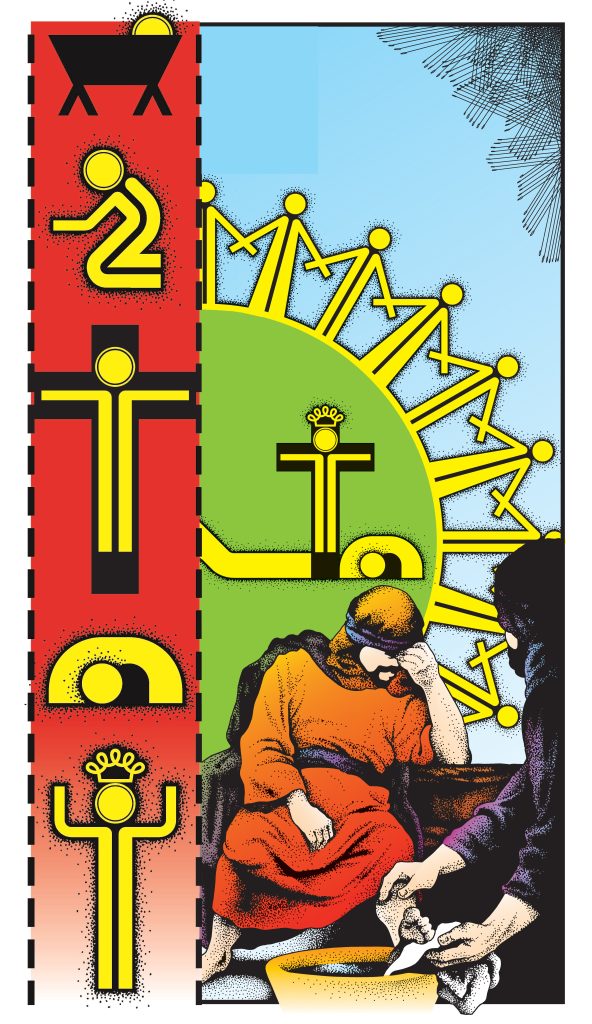
FRAME 19-20: The Coming of the Messiah
(c. 4 B.C. – 30 A.D.)
Finally the Messiah comes! He is born in a simple house in Bethlehem where a manger serves as a crib. He walks the way of a Servant without limit—even to the point of giving away life itself on a cross. The grave cannot hold Him; three days after His crucifixion (coronation), He rises from the dead (vindication), and eventually, in the ascension, is enthroned as King and Lord of the universe.
The King who ate with those considered sinners and outcasts, and washed their feet, has not withdrawn His presence, He continues among His people through the Holy Spirit (dove). While the people of God wait for their Lord’s final appearing, they rejoice in His gracious and full forgiveness, serve each other in love, and reach out to draw others into Jesus’ eternal community. A comparison of frames 2 and 20 shows how God’s plan for creation and humanity is being restored in Jesus; see Ephesians 1:9,10, “to unite all things in Him.”
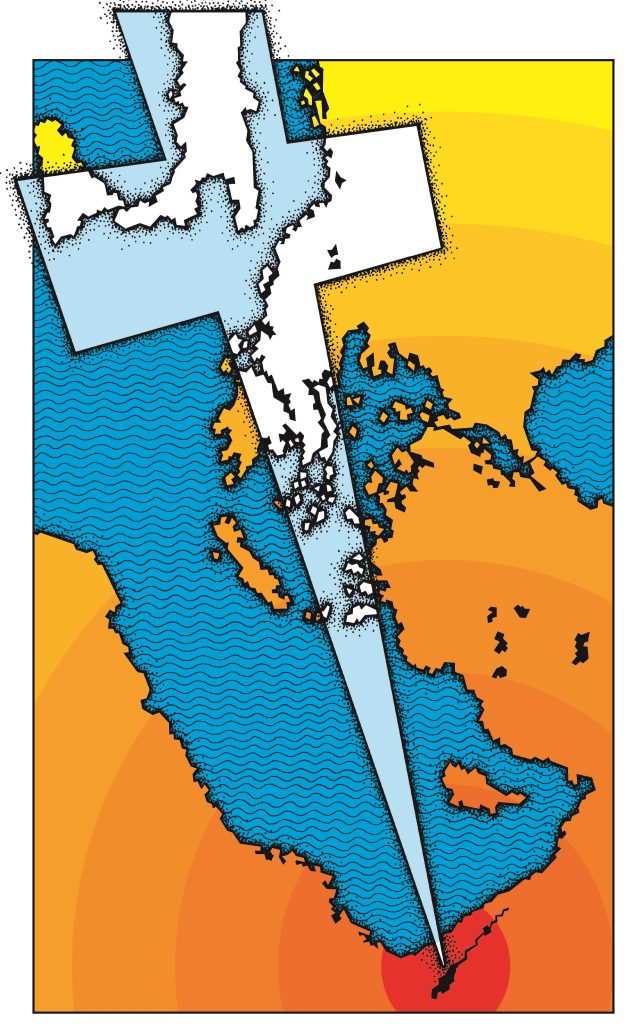
FRAME 21: The Acts of the Apostles
(c. 30 – 100 A.D.)
The Holy Spirit descends upon the apostles at Pentecost, driving them out into the world with the message of Jesus.
On the road to Damascus, the risen Jesus reveals to the apostle Paul that the Jewish “people of the land,” who know little or nothing about the Jewish Scriptures, can belong to God through faith in Jesus crucified, risen and reigning. Jesus the Messiah is the Final Word of God!
Hence the message of salvation through Jesus is to be taken from Judah and Jerusalem to the ends of the earth — even to Rome! Furthermore, because the Jewish laws and traditions have been superseded in Jesus (Galatians 3:24,25), Gentiles can become members of Jesus’ Messianic community directly, and do not first have to become Jews.
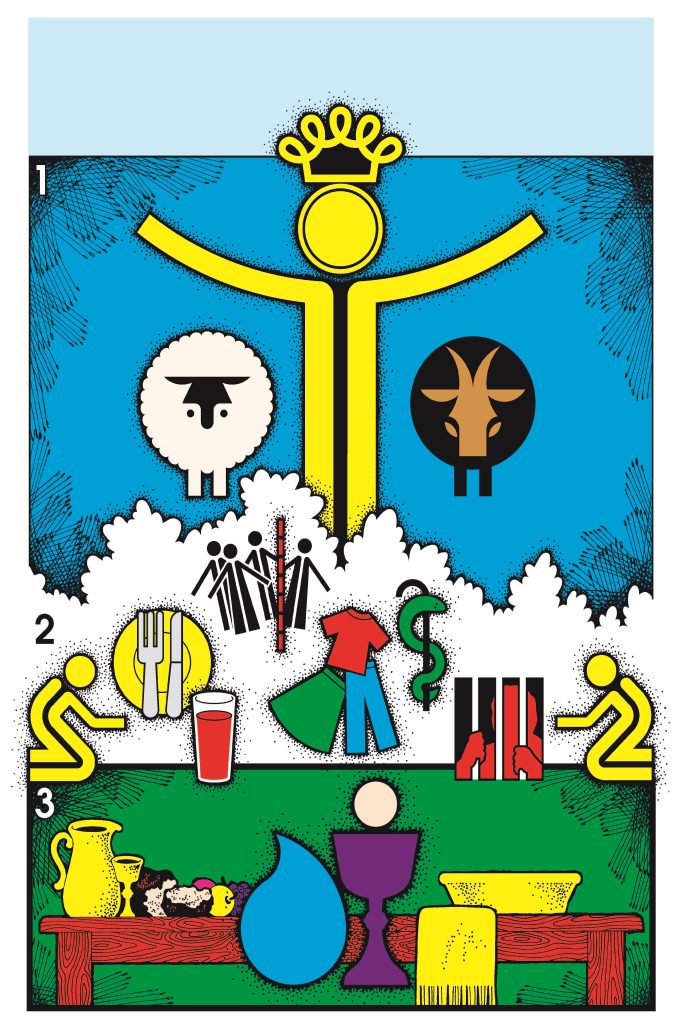
FRAME 22: The Age of the Church
(c. 30 A.D. – Present Day)
Into the present age, the Age of the Church, the Risen Jesus did not withdraw His presence, but transformed it. In this “Body of Christ” Jesus is still alive among us. In the Eucharist, the “edible Word,” Christians partake of Jesus and go forth to become what they eat (center). As Jesus lived to serve and “do feet,” Christians also live to serve and “do feet.”
At the last day Christ will reappear in glory to separate the “sheep” from the “goats” (Matthew 25:31–46). He will commend his flock for caring for Him when He was hungry, thirsty, lonely, lacking sufficient clothing, sick and in prison. In the end, He welcome His people into His eternal home.
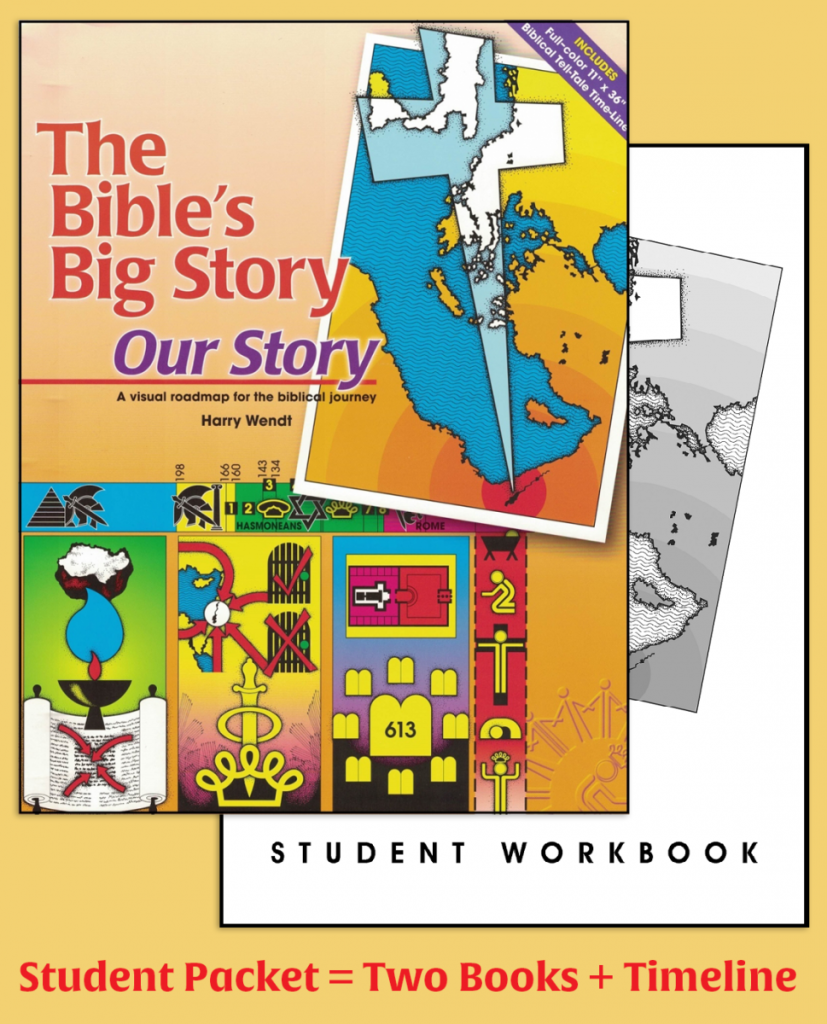
AN INVITATION:
If you find this timeline interesting, you may want to explore it further with a Bible Study that makes use of these same picture frames. The booklet “The Bible’s Big Story: Our Story” by Harry Wendt, describes these same time periods in much greater detail.
Go HERE to order your own copy.
In this Complete Student packet, you will receive the Student Booklet, a foldout copy of the full timeline, as well as a simple Student Workbook that includes questions about the text.
For those who would like to study this material in a group setting, there is also a Leader’s Guide that allows a presenter to go through the full timeline with a large or small group, providing discussion questions and an accompanying answer key.

